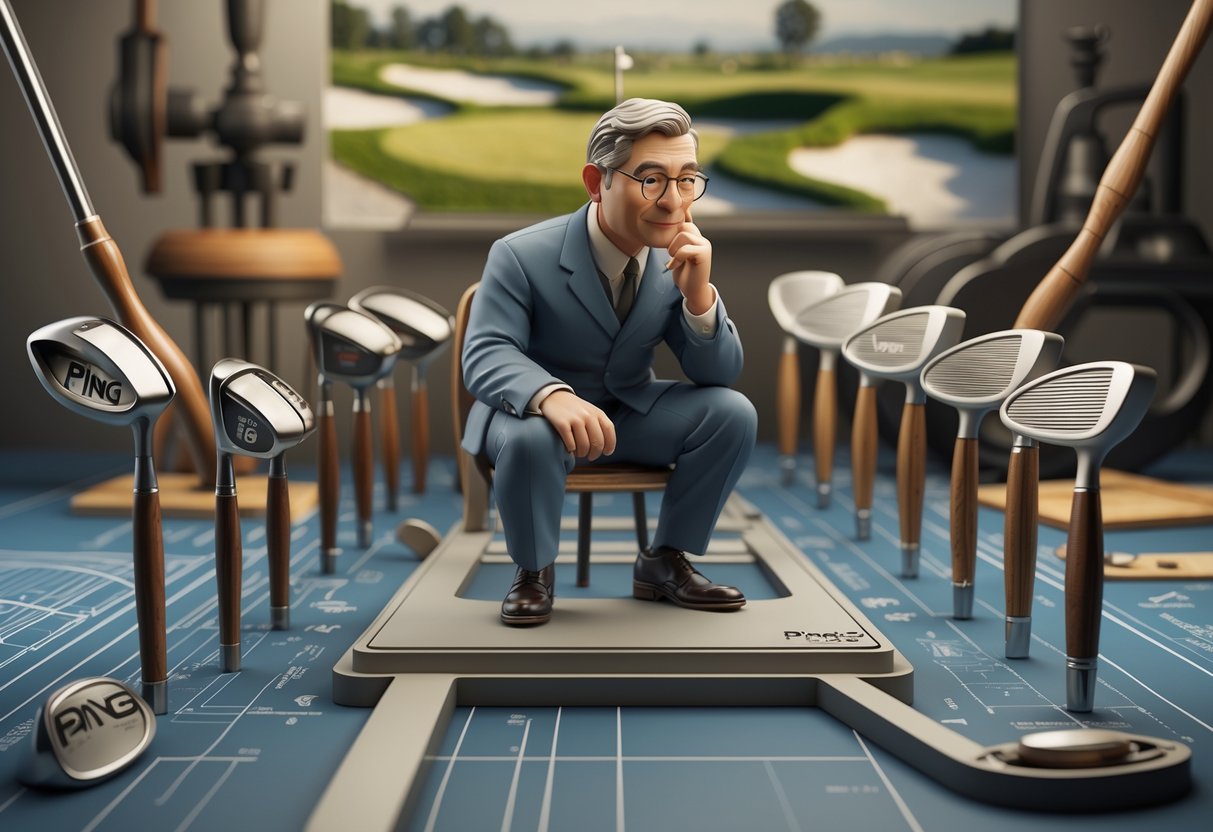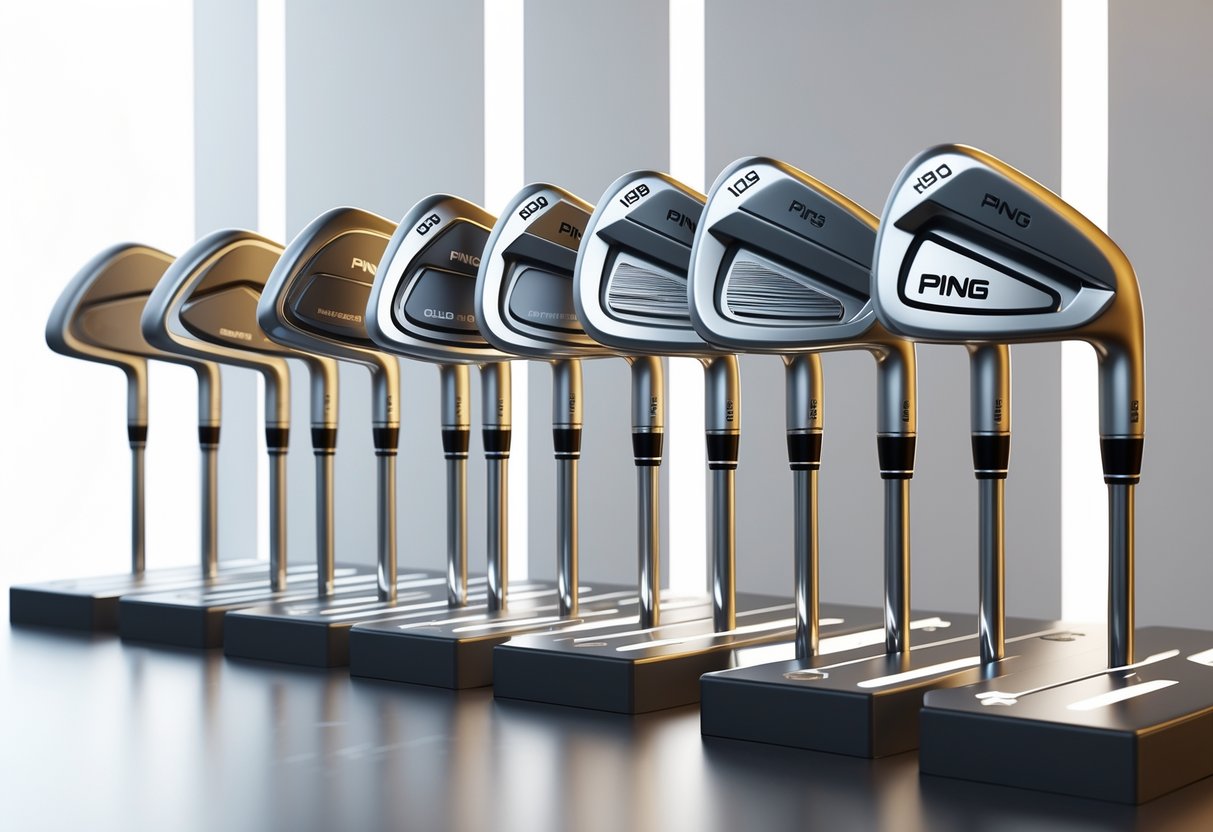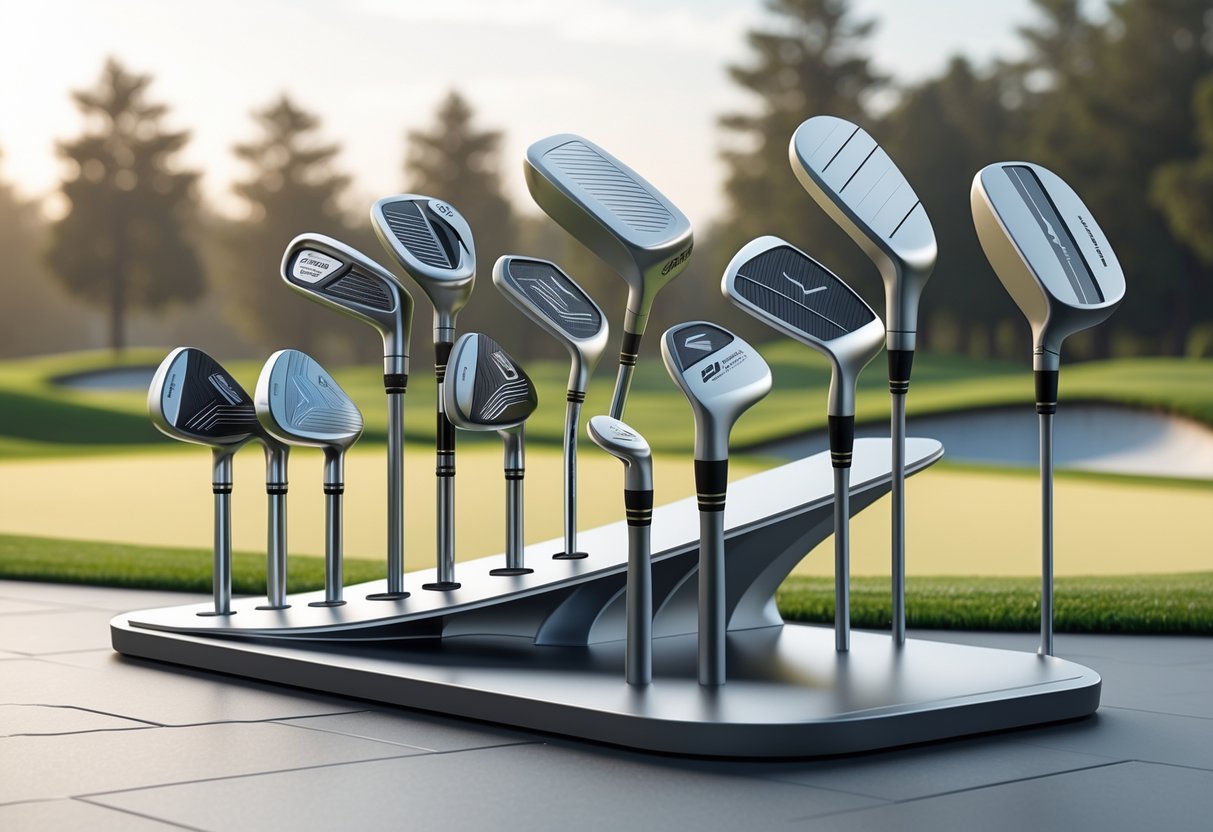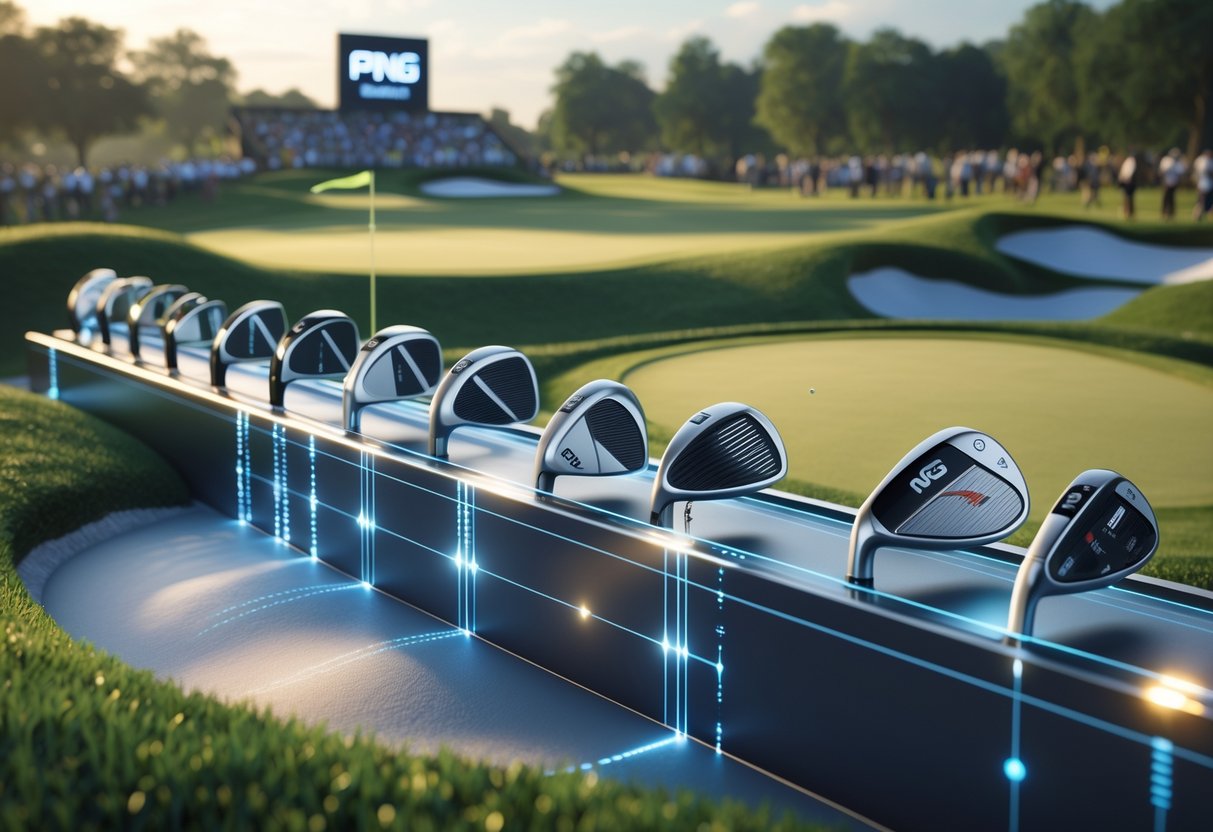Ping System Evolution: A Deep Dive into Club Innovation
Updated On: November 13, 2025 by Aaron Connolly
The Origin of Ping and Karsten Solheim

Karsten Solheim started Ping Golf in 1959, right out of his garage in Redwood City, California. He was just a frustrated golfer who decided to do something about it and ended up changing golf equipment forever.
Solheim’s background in engineering led him to rethink putter design and club fitting. He didn’t just tinker—he brought a whole new approach to how golfers choose their clubs.
Founding in Redwood City
Back in 1959, Solheim set up shop in his garage. As a mechanical engineer, he got tired of missing putts and figured he could build something better.
He didn’t settle for mediocrity. Instead, he used his engineering know-how to create a putter that felt different from anything else.
The name “Ping” actually came from a happy accident. When Solheim hit a ball with his homemade putter, it made this sharp “ping” sound that stuck with him.
That distinctive sound inspired the brand name. It’s funny how a little quirk can end up defining a company.
By 1962, just three years in, a Ping putter had already won its first PGA Tour event. That was a huge deal for such a young company.
Solheim proved that an engineering mindset could compete with—and even outdo—old-school golf brands.
Early Putters and the Anser Legacy
Solheim’s Anser putter is probably his most famous invention. It’s one of the most copied designs in golf history.
The Anser stood out because of its heel-toe weighting, which made it more stable and forgiving. That was a game-changer.
He leaned on engineering principles, using perimeter weighting to move the mass outward. That made the sweet spot bigger and the putter more forgiving on mishits.
Pros quickly picked up Ping putters. Success on tour gave Ping instant credibility, even though they were the new kids on the block.
The Anser’s shape became a blueprint for the industry. Seriously, if you look at most putters today, you’ll see echoes of Solheim’s original design.
Ping also raised the bar for manufacturing. Solheim insisted on precision, making sure every putter matched exact specs.
Solheim’s Engineering Innovations
Karsten Solheim didn’t just rely on tradition—he brought a methodical, engineering approach to golf. He solved club design problems with data and testing, not just gut feelings.
One of his big breakthroughs was custom fitting. He realized golfers aren’t all built the same and shouldn’t use the same clubs.
He created a color code chart for iron fitting. Those colored dots told you exactly what lie angle you needed for your height and swing.
Solheim also introduced investment casting to golf club heads. This let him shape clubs more precisely and control weight better than old forging techniques.
He loved testing. Solheim built mechanical devices to measure club performance, moving past the old “it just feels right” mentality.
His ideas didn’t stop at putters. Ping irons brought in cavity back designs, moving weight around for more forgiveness on off-center hits.
The Birth and Impact of Perimeter Weighting

Ping’s perimeter weighting flipped the script on club design. By moving weight to the heel and toe, Ping made clubs way more forgiving and opened up the game to regular golfers.
Development of Cavity-Back Design
In 1966, Solheim scribbled his perimeter weighting idea on a 78rpm record sleeve. The concept was simple but brilliant.
Old clubs packed weight in the center. Solheim pushed it out to the edges.
That’s how the cavity-back design was born—by carving out the center, he could move weight where it mattered.
Key elements:
- Hollowed-out backs
- Heel and toe weighting
- Bigger sweet spot
- More stability if you miss the center
The Ping Eye iron in 1978 brought this to everyone. Its eye-shaped cavity showed off the tech in a way people could see and feel.
Investment casting let Ping put weight exactly where they wanted. That precision just wasn’t possible with old-school forging.
Advantages for Amateur Golfers
Perimeter weighting fixed a problem that plagued most golfers. Let’s be honest—most shots don’t hit the sweet spot.
This tech kept the club from twisting when you missed the center. Mishits still flew straighter and farther.
Everyday golfers got:
- More forgiveness
- Better distance consistency
- Improved accuracy
- Less sidespin on bad swings
People noticed the difference almost immediately. Shots that used to be disasters became playable.
The bigger sweet spot made more shots feel solid. That’s a confidence boost right there.
Distance didn’t drop off as much on toe or heel strikes. Even a less-than-perfect shot could still fly a decent distance.
Influence on Modern Club Manufacturing
Ping’s perimeter weighting changed the whole industry. Competitors scrambled to catch up.
Cavity-back irons became the norm for anyone wanting an easier game. Now, every brand has a perimeter-weighted option.
Today’s clubs feature:
- Hollow-body iron designs
- Perimeter weighting in drivers and woods
- Adjustable weight systems
- Multi-material builds for perfect balance
Engineers now use computer modeling to fine-tune weight placement. They can control every gram.
The idea has gone way beyond simple cavities. Clubs now use tungsten, carbon fiber, and all sorts of internal tricks.
You’ll find perimeter weighting everywhere—in putters, drivers, wedges. It’s just part of the DNA of modern clubs.
Key Milestones in Ping Iron Development

Ping’s iron journey stretches back over sixty years, starting with the Karsten series and leading up to the Eye2 irons that basically rewrote the rules. Each new model brought more forgiveness, distance, and tech.
From Karsten Irons to Eye Series
Between 1969 and 1976, Ping rolled out the Karsten I, II, III, and IV irons. These clubs set the tone for Ping’s perimeter weighting.
The Karsten irons featured cavity-back designs that pulled weight away from the middle. That boosted the moment of inertia (MOI), so the clubhead twisted less on mishits.
Golfers started seeing straighter shots, even if their strike wasn’t perfect.
The early 1970s brought the Ping Eye irons. They built on the Karsten foundation, with even better cavity-back designs.
In 1979, Ping launched the Eye series. That was a big leap. They widened the soles and pushed perimeter weighting further than ever.
Breakthroughs: Eye2, Zing, and G Series
The Ping Eye2 irons became the best-selling irons ever. When they dropped in the early ‘80s, golfers noticed those U-shaped grooves.
Those grooves cranked up spin rates, letting players control shots like never before.
But it wasn’t just about spin. The Eye2’s wide sole and big cavity-back made the game a lot more forgiving for regular golfers.
After Eye2, Ping brought out the Zing series. The Zing irons kept the forgiveness but looked and felt a bit sleeker.
Golfers who liked Eye2 performance but wanted a more compact look gravitated to Zing.
The Ping G series hit in the 2000s, aimed at mid-handicappers. These irons had bigger heads and wider soles, making it easier to get the ball in the air.
Evolution of i Series and Blueprint
The Ping i series became the go-to for skilled players. These irons focused on precision and control, not just forgiveness.
i-series irons had compact heads and thinner toplines—just what low handicappers wanted.
The latest i-series, like i525 and i230, use forged construction for a buttery feel. Skilled golfers can shape shots and get detailed feedback.
Ping Blueprint irons are all about precision. These blade-style clubs are for pros and top amateurs.
Blueprint irons have minimal offset and tons of workability. But Ping still sneaks in some perimeter weighting, so they aren’t punishing on mishits.
Even the most demanding players get a bit of forgiveness, which is pretty clever.
Iconic Ping Iron Models by Decade

Ping’s most iconic irons shaped the game over three distinct eras. From the original Eye series to the modern G430, each decade brought something new to the table.
1970s–1980s: Eye and Eye2
Ping Eye irons hit the scene in 1979 and kicked off Ping’s reputation for forgiveness. These cast irons had wide soles and perimeter weighting, making it easier to hit straight shots.
The Eye2 truly became legendary when it arrived in 1982. With a bigger sweet spot and that unmistakable sound, these irons won over golfers everywhere.
Key features:
- Durable cast construction
- Wide soles for better turf contact
- Perimeter weighting for extra stability
- Easy-to-launch design
The Eye2 irons sold better than any other set in history. Even now, you’ll see them in bags, decades after their debut.
1990s: The Rise of Zing and ISI
The Ping Zing irons came out in 1991 with a sleeker look than Eye2. Better players liked the forgiveness but didn’t want bulk.
Zing 2 followed in 1994, upping the feel and distance. The Zing line also offered different sole widths for different swings.
The Ping ISI K arrived in 1999 as Ping’s first real game-improvement iron. These irons had:
- Bigger clubheads
- Lower center of gravity
- More perimeter weighting
- Smoother turf interaction
Every model stuck with Ping’s custom fitting and color-coded lie angles.
2000s–Present: G, S, and i Series Releases
Ping split its irons into three main lines. The i-series went after skilled players, the G-series focused on game-improvement, and the S-series was for tour pros.
Big releases included the i5 (2004) for mid-handicappers and S58 (2005) for better players. The G2 (2006) brought in multi-metal construction.
Recent years have seen the G400 (2017), G425 (2020), and G430 (2022) with new face tech. The i-series kept evolving with models like i210 and i525.
The i59 sits at the top as a premium forged iron, while the G430 packs the latest forgiveness features and faster ball speeds.
Technological Advancements in Ping Irons

Ping has shaken up golf iron tech in three big ways: better materials, smarter fitting, and designs that squeeze out more forgiveness and distance. These changes have made golf more fun for everyone.
Materials and Manufacturing Evolution
Ping didn’t stick with plain old steel. In the ‘80s, they brought in beryllium copper with the Eye2 BeCu models. That gave golfers a softer feel and more control.
Modern irons like the i500 use hollow-body construction and thin faces. That combo means more ball speed, but you still get feedback.
Ping now uses carbon fiber in smart ways. They put it where it saves weight and helps dial in the center of gravity. The i525 irons are a great example of this.
Today’s Ping irons blend steel, tungsten, and lightweight materials in all the right places. This multi-material approach lets engineers fine-tune performance for different swings and skill levels.
Custom Fitting and Player Adaptation
Ping’s colour dot system stands out as their biggest fitting breakthrough. Each coloured dot matches up to a specific lie angle tweak. Golfers use this system to dial in the right club setup for their height and wrist-to-floor measurement.
The colour coding system breaks down like this:
- Black dot: Standard lie angle (0 degrees)
- Blue dot: 1 degree upright
- Red dot: 1 degree flat
- Green dot: 2 degrees upright
Ping didn’t stop at lie angles—they brought in length and grip customisation too.
During modern fittings, fitters use launch monitors and impact tape. That data-driven process helps golfers get specs that fit their swings.
Ping also created different iron types for different players. Game-improvement irons like the Ping G425 irons give you tons of forgiveness.
Players’ irons offer more control and allow for shot shaping.
Forgiveness and Distance Innovations
Perimeter weighting became Ping’s signature move with the Eye2 irons. They moved weight from the centre out to the edges, which made off-centre hits much more forgiving.
Ping rolled out cavity back designs that kept evolving. Using computer models, they fine-tuned weight distribution for better performance.
Modern irons have deeper cavities and smarter mass placement.
Ping pushed face technology further by focusing on ball speed and consistency. They built variable face thickness designs, and those thinner faces flex more at impact. That means higher ball speeds across the whole face.
Recently, Ping added custom tuning ports and adjustable weighting systems. Golfers can tweak ball flight to match their swing speed and attack angle.
The Expansion into Putters and Other Clubs

Ping started with putters back in 1959 and quickly grew into a full club manufacturer. Their reputation really took off with innovative putter designs like the Anser, before they moved into full iron sets and built out whole product families.
Anser, Zing, Ally, and Redwood Models
The Anser putter launched in January 1966 and became Ping’s most iconic design. Karsten Solheim actually sketched the idea on a record album dust jacket—talk about inspiration striking at odd moments. That heel-toe weighted putter changed golf forever.
Perimeter weighting in the Anser boosted forgiveness. Pretty soon, most modern putters followed its lead.
The Zing series was Ping’s first big iron expansion. They brought the same engineering from putters into full club sets.
With the Ally putters, Ping kept innovating. Those models used advanced materials and refined weighting.
The Redwood line showed Ping could make premium gear too. Named after their roots in Redwood City, California, these clubs nodded to tradition but kept pushing forward.
Each model line pushed custom fitting. Ping led the way in personalised club specs, way before everyone else caught on.
Modern Putter Families: Nome and Beyond
Ping’s current putter lineup splits into families for different player needs. The Nome series brings in modern design and high-tech materials.
Today’s Ping putters use precision-milled faces for a consistent roll. They mix steel, aluminium, and synthetic inserts for performance.
The Vault Series, which launched in 2014, introduced customisable weighting. Players can tweak head weight to match their stroke.
In 2021, the Heppler Series arrived with new face patterns. These putters help create a more consistent roll with improved surface tech.
Special editions like the PLD (Ping Limited Edition) series celebrate big tournament wins. The PLD Pal 2, for example, marked Jeff Sluman’s 1988 PGA Championship victory.
Each putter family fits a different putting style. Blade putters fit traditional strokes, while mallets help players with an arc-style motion.
Integration with Iron Series
Ping changed iron design by bringing putter engineering to the whole set. Their perimeter weighting idea really changed how we think about forgiveness.
Early iron series used the same custom fitting approach as the putters. Lie angle tweaks became the norm.
Modern Ping irons and putters work together easily. For example, G-series irons pair up with G-series putters for a familiar feel.
Cast and forged construction suit different players. Game-improvement irons use casting for extra forgiveness.
Ping’s colour dots help players pick the right specs. Those lie angle dots keep your setup consistent from club to club.
Their iron tech includes faces that flex for more distance. Variable thickness faces boost ball speed across the hitting area.
Influence of Ping on the PGA Tour

Ping shook up pro golf with smart partnerships and wild equipment breakthroughs. They worked directly with tour players and racked up consistent wins for over sixty years.
Adoption by Tour Professionals
John Barnum grabbed the first PGA Tour win with Ping gear at the 1962 Cajun Classic Open Invitational. That breakthrough moment showed Ping clubs could hang with the best.
The big shift happened in 1967. Julius Boros used the famous Anser putter to win the Phoenix Open, and suddenly Ping was everywhere in the pro game.
By the 1980s, tour players widely used Ping irons. The Eye2 irons, with their perimeter weighting and forgiveness, really changed things.
Now, 36 PGA Tour players regularly use Ping clubs. Viktor Hovland and Tony Finau are just a couple of big names showing Ping’s staying power at the top.
Karsten Solheim’s colour-coding system helped pros nail their fitting needs. That innovation made custom fitting standard practice for the pros.
Ping Milestones in Major Championships
Ping has picked up over 10 wins on the PGA Tour this season. That puts them among the top for tour victories.
The Anser putter has shaped putting for more than 50 years. Its success in the majors built Ping’s reputation for precision.
Ping irons have a strong record in the big tournaments too. The Eye2 series alone helped rack up plenty of pro wins in the ‘80s and ‘90s.
Pros trust Ping clubs in high-pressure moments when accuracy matters.
Collaboration and Feedback from Players
Ping’s tour pros give feedback that directly shapes new products. The fitting process with these players generates loads of useful data.
Tour fitting specialists use tech like Trackman and Foresight. They measure spin rates and ball flight—stuff you just can’t see with the naked eye.
The G25 driver stands out as Ping’s biggest design leap between models. That change came straight from data collected during pro fittings and swing analysis.
Pros test prototypes before they ever hit the shelves. Their input tweaks everything from club head shape to shaft specs.
The nFlight fitting system leans heavily on tour player insights. This custom tech mixes pro feedback with advanced measurement tools for better results.
Female-Focused Designs and Product Lines

Ping realised that women golfers needed clubs built for their swings and physical needs. They didn’t just shrink men’s clubs and paint them pink—they actually engineered dedicated women’s lines.
The Rhapsody Series
The Ping Rhapsody series was a real leap in women’s golf equipment. These clubs were lighter to help women swing faster. They designed the shafts with different flex points to fit typical women’s swing speeds.
Ping gave Rhapsody drivers bigger sweet spots. That made it easier for women to find solid contact and get more distance, even on mishits. The club heads used different weight setups than the men’s versions.
Matching iron sets came with progressive weighting. Each iron fit the ball flight patterns women usually create. Shorter irons had more weight low in the sole, so getting the ball airborne was easier.
Key Rhapsody Features:
- Lighter club weight
- Custom shaft flex for women
- Larger sweet spots on drivers
- Progressive iron weighting
Design Considerations for Women
We noticed women’s golf gear needed a different engineering touch. Women generally swing slower than men, so clubs have to help them get distance at lower speeds. Ping’s engineers spent a lot of time studying women’s swing patterns.
They found women benefit from higher launch angles. So, Ping added loft to help get the ball up. Grips were made smaller to fit women’s hands.
Weight placement became a big deal. Ping shifted weight lower and deeper in the club heads, making it easier to launch the ball. Shaft lengths were tweaked to match women’s heights and arm lengths.
Women-Specific Design Elements:
- Higher loft for easier launch
- Smaller grips
- Lower centre of gravity
- Adjusted shaft lengths
Market Reception and Success
Women golfers responded well to Ping’s dedicated approach. Sales showed more women bought full sets when clubs were actually designed for them.
Golf shops noticed more interest from female players. Many women liked that the clubs looked classy, not just girly. The performance boost was obvious, no matter the skill level.
Professional women golfers began endorsing Ping’s women’s lines, which gave them extra credibility. Amateur players saw the same technology working for the pros.
Ping expanded their women’s offerings after this success. They introduced clubs at different price points to reach more players. This helped them take market share from brands that lagged behind in women’s equipment.
Series Deep Dives: G, i, S, and Rapture

These four series really show how Ping approaches iron design for different players. Each one targets a specific skill level and playing style, using its own tech and design philosophy.
Ping G Series Journey
The G series is Ping’s main game-improvement line. It started with the G2 and has gone through a bunch of generations, each adding more forgiveness and distance.
G15 irons were a big deal in 2009. They had a wider sole and deeper cavity back, which helped average golfers hit higher, straighter shots.
The G25 came out in 2013 with Custom Tuning Port tech for better weight distribution. Players got improved feel and more consistent shots.
G30 irons landed in 2014 with an even bigger profile. Long irons gave max forgiveness, while short irons allowed better control.
The G400 irons showed up in 2017 with a maraging steel face for extra speed. The G410 series took that further, adding improved acoustics.
G700 and G710 models broke new ground with hollow-body construction. They looked like irons, played like hybrids, and gave mid-to-high handicappers a real distance boost.
i Series Innovation
The i series grew out of Ping’s Eye models. It targets better players who want some forgiveness but still care about looks. The i3 models kicked off the line in 2000.
This series sits between game-improvement and players’ irons. It appeals to mid-handicappers who want a sleeker look. The smaller club head was a conscious choice.
i20 irons dropped in 2011 with a more compact shape and perimeter weighting for stability. The progressive design offered different levels of help throughout the set.
i25 models arrived in 2013 with Custom Tuning Port tech for precise centre of gravity. Players got better launch and distance control.
The i series always offered a clean look at address. Tour pros liked these more than the G series, thanks to the balance of tradition and forgiveness.
S Series Design
The S series is Ping’s pure players’ iron. These clubs focus on feel, workability, and shot-shaping, not max forgiveness.
S55 irons came out as compact, blade-like clubs for skilled golfers. The thin topline and almost no offset appealed to better players. Forged construction gave amazing feel.
There’s very little perimeter weighting here. The idea is to reward great strikes and make you pay for misses. It’s a design that encourages you to develop your swing.
S55 models became favourites among teaching pros and low-handicap amateurs. The feedback is instant and honest—players can really tell how well they’re striking the ball.
Ping kept this series pretty steady over the years. Players’ iron buyers value consistency, so major changes just weren’t needed or wanted.
Learning from Rapture Models
Ping kicked off the Rapture series in late 2006, diving into multi-material irons. This lineup joined the G5 family, introducing titanium faces, tungsten weights, and composite bits.
The Rapture irons used lightweight titanium faces, which freed up weight. Ping added tungsten in the toe, letting golfers square the clubface more easily for straighter shots.
Ping replaced the original Rapture models with Rapture V2 in late 2008. The new version kept the multi-material idea but tweaked sound and feel based on player feedback.
They didn’t keep either model around for long, but Ping learned plenty from the experiment. The multi-material design shaped future Ping clubs. You can spot Rapture tech in later G series and i series irons.
By rolling out the Rapture, Ping showed it’s not afraid to try bold ideas. Golfers seemed to enjoy the tech when it worked. The series played a big part in building Ping’s reputation for pushing iron design forward.
Rules, Standards, and the Role of Governing Bodies

The United States Golf Association (USGA) has shaped every big step in Ping’s club design with strict equipment regulations. They’ve approved breakthroughs and banned controversial groove patterns, drawing the line for what makes it onto the course.
USGA Regulations and Ping Innovation
The USGA’s equipment standards committee checks every Ping club before golfers ever see it. Their rules cover club head size, groove shape, and even materials.
Ping’s engineers work closely with USGA officials as they develop new clubs. They send in prototypes months ahead to make sure everything follows the Rules of Golf.
Key USGA Standards for Ping Clubs:
- Drivers can’t go over 460cc in head volume
- Groove width has to be under 0.035 inches
- Club faces can’t bounce the ball too much (no trampoline effect)
- Weight distribution must meet moment of inertia rules
Ping pushes right up to these limits but always stays within the rules. The company often finds ways to squeeze out more performance while complying.
Square Grooves Controversy
Ping’s biggest run-in with golf’s rule makers came with the Eye2 irons’ square grooves. When they launched in 1982, those U-shaped grooves gave players a ton of spin control.
Most clubs had V-shaped grooves before that. Ping’s square grooves grabbed the ball better, especially out of the rough. Pros immediately noticed their short game got sharper.
At first, the USGA gave the Eye2 irons the green light. But in 1990, they changed groove rules and banned square grooves for pros. That kicked off a legal battle that dragged on for years.
Ping stood its ground, saying the clubs met the specs when approved. Eventually, both sides settled—golfers who already owned Eye2 irons could keep using them in tournaments.
Other brands like Titleist had to rework their grooves to fit the new rules. This whole saga pushed equipment makers and rule makers to communicate more clearly.
Ongoing Approvals and Limitations
Every modern Ping club goes through intense USGA testing before approval. The USGA uses robots and precise tools to check every detail.
Current USGA Testing Process:
- They test driver faces for how much energy they return (coefficient of restitution)
- Precision tools measure groove conformity
- Club head aerodynamics get a close look
- They analyse what materials go into each club
Ping built a compliance team that keeps an eye on rule changes. Sometimes they even help shape new regulations through technical committees and feedback.
Ping’s engineers have to balance wild ideas with what the rules allow. New rules on driver faces and groove sharpness have forced them to get creative.
Some Ping designs never see daylight because the USGA says no. The governing body keeps tightening equipment rules to make sure skill, not just tech, decides who wins.
Latest Models and the Future of Ping Clubs
Ping’s latest clubs pack big leaps in distance and forgiveness. Their pipeline hints at even more exciting tech on the way. The G440 series leads the charge, with irons built for all skill levels.
Recent Releases: G430, G425, i525, Blueprint
Ping dropped the G440 series in 2025, showing off a new way to move weight around. These drivers have the lowest centre of gravity Ping’s ever made, chasing distance over pure forgiveness.
All three G440 drivers (Max, SFT, LST) use new internal designs to save weight. Instead of just pushing the mass to the edges, Ping lowered the centre of gravity to cut spin and boost distance.
The G440 irons follow suit with faster ball speed tech. Ping used a new heat-treatment process on the 17-4 steel, letting them make faces 9% thinner than the G430s.
Ping’s latest irons target different types of golfers:
- Ping i530: A player’s distance iron with a blade-like look
- Ping G730: Built for high handicappers, these focus on launch and forgiveness
These fill out Ping’s iron lineup, sitting between the Blueprint and G430 models.
Anticipated Technologies
Ping looks set to keep chasing smart weight distribution systems. The G440’s moveable centre of gravity hints at even more advanced internal weight tricks coming soon.
They’re still working on face technology. Variable-thickness faces are showing real promise for faster ball speeds without giving up durability.
We’ll probably see better fitting technologies too. Ping’s all-in on custom fitting, so digital analysis tools will only get sharper and easier to use.
Sustainable materials are likely to show up in future clubs. The whole golf industry is poking around eco-friendly ways to build clubs without losing performance.
The Direction of Golf Club Evolution
Ping seems to be steering toward personalised performance optimisation. Instead of one-size-fits-all, future clubs will let golfers dial in specs more precisely.
Distance enhancement keeps driving new ideas. The G440’s spin reduction is just one way Ping is chasing longer, more efficient shots.
Forgiveness tech is still at Ping’s core. Future clubs will keep helping everyday golfers, but they’ll also add more distance.
Multi-material construction is only getting more important. Mixing metals and composites lets engineers put weight exactly where they want it.
It seems likely that AI-assisted fitting will become the norm. Soon, tech may crunch your swing data and spit out the perfect club specs, no guesswork needed.
Frequently Asked Questions

Network ping systems have changed a lot thanks to lower latency, AI-optimised traffic, and smarter predictive algorithms. Today’s solutions handle real-time challenges with better monitoring and more reliable mobile connections.
What advances have been made in reducing latency for networked games?
Game developers now put servers closer to players with edge computing. This move drops ping times from 100ms to under 20ms in lots of places.
Dedicated gaming networks from AWS and Google Cloud give games priority. They send data through faster, less crowded routes than regular internet.
Game makers also use client-side prediction. Your actions show up instantly on your screen, while the server quietly confirms them. This trick makes games feel smooth, even with a bit of lag.
How has network monitoring become more efficient in recent years?
Modern monitoring tools track thousands of network nodes all at once. They spot issues before users even notice by looking for weird traffic patterns.
Machine learning now catches unusual network behaviour automatically. These systems can flag possible failures hours ahead, not just after folks start complaining.
Cloud-based monitoring gives admins a global view from one dashboard. They can check performance across different regions and tweak routing right away.
What are the latest developments in managing network congestion for real-time applications?
Traffic shaping tech now gives priority to certain data types automatically. Video calls and games get first dibs over downloads when things get busy.
Software-defined networking can shift bandwidth on the fly. It reroutes traffic through emptier paths when congestion pops up.
Quality of Service protocols keep getting smarter. They can tell the difference between an esports match and casual browsing, handing out resources as needed.
In what ways have predictive algorithms improved the stability of network connections?
These systems look at past connection patterns to guess when network loads will spike. They set aside extra bandwidth before peak gaming hours hit.
Algorithms learn from how users behave. They can predict when someone might hit connection issues based on where they are, the time, and network conditions.
Modern routers use predictive buffering to smooth things out. They preload data before you need it, cutting down on interruptions.
Can you explain the role of artificial intelligence in optimising network traffic?
AI constantly reads network performance data and finds the best routes. It tweaks traffic flow thousands of times a second, all on its own.
Smart load balancers spread users across servers based on live performance data. AI checks server load, distance, and network health before sending you anywhere.
Machine learning models spot network failures before they hit. This lets systems reroute traffic ahead of time, not just scramble to fix things after something breaks.
What approaches are being taken to enhance the reliability of mobile network pinging?
5G networks now offer more consistent ping times by using dedicated network slices. With this setup, gaming traffic gets its own reserved bandwidth—other apps just can’t touch it.
Carriers also combine multiple network bands through carrier aggregation. By doing this, they keep connections steadier and cut down on those annoying ping spikes you get when jumping between cell towers.
Mobile edge computing puts servers right inside the cellular network infrastructure. This move chops out several network hops that used to tack on extra latency to mobile connections.

